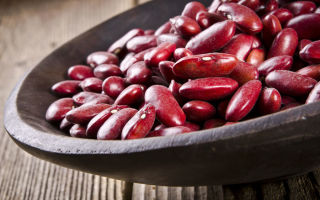Content
- 1 The chemical composition of red beans
- 2 Nutritional value and calorie content of red beans
- 3 The benefits of red beans for the body
- 4 Is red beans possible for pregnant women
- 5 Red beans when breastfeeding
- 6 At what age can red beans be given to children
- 7 Red beans for weight loss
- 8 Red beans in traditional medicine
- 9 The use of red beans in cosmetology
- 10 Red beans in cooking
- 11 Harm of red beans and contraindications
- 12 Selecting and storing red beans
- 13 Conclusion
- 14 Reviews
Red beans are the leader in the content of antioxidants, which are also called "scavengers of free radicals", which means that the product has properties to prevent premature aging and reduce the risk of cancer and other serious diseases.
The benefits and harms of red beans are determined primarily by their chemical composition.
The chemical composition of red beans
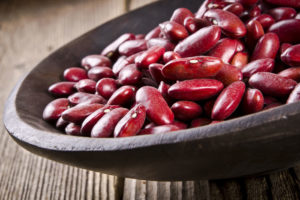
Red beans contain all the useful vitamin and mineral complex necessary for the full functioning of the body.
Content of macro- and microelements per 100 g of product based on the percentage of the recommended daily requirement (RDA)
|
Trace elements |
mg |
RSP,% |
Potassium, K |
403 |
16 |
|
Calcium, Ca |
28 |
3 |
Magnesium, Mg |
45 |
11 |
|
Sodium, Na |
238 |
18 |
Phosphorus, P |
142 |
18 |
|
Trace elements |
Iron, Fe |
2.94 |
16 |
||
|
Manganese, Mn |
0.48 |
24 |
Copper, Cu |
0.24 |
24 |
|
Selenium, Se |
1.2 |
2 |
Zinc, Zn |
1.07 |
9 |
Vitamin content per 100 g of product based on RDA
|
Vitamin K |
8.4 μg |
7% |
|
Vitamin B1, Thiamin |
0.16 mg |
11% |
|
Vitamin PP, NE |
2.29 mg |
11% |
|
Vitamin PP, Niacin |
0.58 mg |
3% |
|
B vitamins |
||
|
Vitamin B2, Riboflavin |
0.06 mg |
3% |
|
Vitamin B4, Choline |
30.5 mg |
6% |
|
Vitamin B5, Pantothenic Acid |
0.22 mg |
4% |
|
Vitamin B6, Pyridoxine |
0.12 mg |
6% |
The benefits of B vitamins are manifested in cellular metabolism, increased immunity, healthy skin and hair.
Vitamin PP and nicotinic acid contribute to the assimilation of red bean protein and ensure the health of the nervous and cardiovascular systems, and improve visual acuity.
In addition, red beans are a rich source of essential amino acids:
|
Arginine |
0.54 g |
|
Valine |
0.45g |
24% |
|
Histidine |
0.24 g |
22% |
Isoleucine |
0.38 g |
25% |
|
Leucine |
0.69 g |
21% |
Lysine |
0.6 g |
19% |
|
Methionine + Cysteine |
0.22 g |
15% |
Threonine |
0.37 g |
23% |
|
Tryptophan |
0.1 g |
25% |
Phenylalanine + Tyrosine |
0.71 g |
25% |
Tryptophan - has pronounced sedative properties, helping to overcome depression, normalizing sleep and tension.
Arginine - supports the reproductive sphere and is part of collagen, providing the skin with elasticity.
Lysine - protects against the harm of viruses and infections, protects against cancer.
Tyrosine - useful in regulating the endocrine system, works as an antioxidant and antidepressant, reduces the likelihood of allergic reactions.
Histidine - is included in hemoglobin, helps with anemia.
Nutritional value and calorie content of red beans
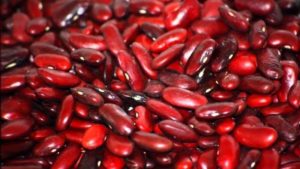
Red kidney beans are rich in high quality, easily digestible protein, equal to the benefits of meat and fish proteins.
The energy value of 100 g of the product is: 127 kcal - this is 6% of the RDI.
Nutrients
|
Carbohydrates |
15.4 g |
5% |
|
Fats |
0.5 g |
1% |
|
Protein |
8.67 g |
14% |
|
Alimentary fiber |
7.4 g |
37% |
|
Cholesterol |
0 mg |
0% |
One glass of beans contains the daily requirement of soft fiber, which, in combination with complex carbohydrates, exhibits the properties of quickly saturating the body, maintaining a feeling of fullness and providing the body with energy for a long time, as well as detoxifying and helping in the prevention of neoplasms.
The benefits of red beans for the body
The beneficial properties of beans lie mainly in their high nutritional value, which can rival those of animal products.
In addition to their high antioxidant properties, red beans have a number of benefits:
- Vitamins B1, B6 ensure the stability of the immune system, protects the body from the action of viruses. In addition, vitamin B1 stimulates the metabolism and functioning of the nervous system, providing the body with stress resistance.
- The product is able to improve digestion due to the development of beneficial intestinal microflora with the help of dietary fiber, a particularly high amount of which is contained in the skin of beans. Therefore, they are indicated for constipation problems.
- A high percentage of fiber content has a laxative effect on the intestines and also helps to cleanse the body of harmful toxins, toxins, heavy metals, cholesterol, which in turn helps to prevent atherosclerosis.
- The benefit of red bean fiber is its ability, with the help of intestinal bacteria, to help create short-chain fatty acids that become a source of energy, so necessary for men, athletes and people whose activities are related to physical activity, as well as those who are going through a rehabilitation period. after illness.
- Choline regulates the lipid metabolism of the liver, helps to relieve the inflammatory processes of this filter of the body.
- The benefits of red beans to regulate acidity in the body are indicated for people with problems of the gastrointestinal tract, as well as overweight.
- The diuretic properties of beans help to remove stones from the kidneys and gallbladder, and eliminate infections in the urinary system.
- Red beans are indispensable in the diabetic menu - thanks to arginine, which can effectively lower blood glucose levels.
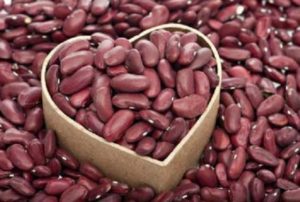
- The content of calcium and potassium endows the product with useful properties to normalize the work of the cardiovascular system, regulate blood pressure, and cope with hypertension at different stages.
- Folic acid contained in beans is able to reduce homocysteine in the blood that breaks blood vessels, promote the process of hematopoiesis and, in combination with iron, prevent the harm of anemia, as well as supply oxygen to tissues and organs.
- Red beans are also indicated for muscle cramps: in their power to reduce their severity.
- Red beans are also highly valued in cosmetology due to their beneficial properties to regenerate the skin, increase its elasticity and cope with anti-aging changes.
Is red beans possible for pregnant women
Folic acid in the composition of the product is necessary to support the intrauterine development of the organs and systems of the unborn baby. The beneficial properties of folic acid are manifested during the formation of the fetal neural tube, therefore the product is especially recommended in the menu of pregnant women.
Red beans for pregnant women are also beneficial for their pronounced sedative effect, since hormonal fluctuations in the body of a woman in this state affect her emotional background.

The richness of iron in the bean product supports the processes of hematopoiesis and helps in the prevention of anemia.
And the properties of red beans to relieve muscle spasms and regulate water metabolism will benefit a woman's health in late pregnancy by reducing the harm to muscle cramps and edema.
In the absence of gastroenterological contraindications, moderate consumption of the product will also be useful for solving such frequent pregnancy problems as toxicosis and constipation.
Red beans when breastfeeding
During the period of breastfeeding, beans are able to help both the mother's body in recovery due to the valuable protein composition, and the child's body in obtaining the vitamin and mineral complex, which the plant is rich in.
To enhance lactation, it is recommended to use bean puree soup.
The necessary useful properties of red beans during breastfeeding will be to strengthen bone tissue, muscles, normalize water metabolism, saturate the body with oxygen, and strengthen immunity.
The benefits of bean soup will be irreplaceable due to its lightness, low calorie content (60 kcal per 100 g) and at the same time - nutritional value and easy digestibility.
To prepare it you will need:
- 200 g beans;
- 3 liters of water;
- 5 potatoes;
- 2 carrots;
- 1 onion;
- salt to taste.
The beans are washed, soaked in plenty of water for up to 10 hours, and the water is changed every 3 hours. Swollen beans, chopped vegetables are placed in boiling water, cook until tender for about 1 hour. The cooled soup is whipped with a blender and, if desired, boil for up to 10 minutes.
At what age can red beans be given to children

As a hypoallergenic product that contains almost all amino acids, red beans should definitely be included in the children's diet, given the characteristics of the product. During the cooking process, the beans do not lose their beneficial properties.
Only ripe beans that are hard to digest by the stomach can harm a baby's digestive disorders, therefore, young leguminous beans, which pediatricians recommend for use after one year in the form of light mashed potatoes or light cream soups, will be the best option for children. Steam cooking options are especially helpful.
Ripe beans 2 times a week can be given to a child after 2 years.
Red beans for weight loss
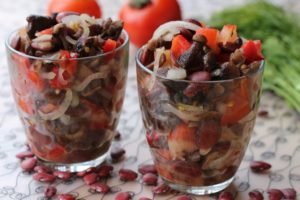
The peculiarity of the combination of the beneficial properties of fiber and slow carbohydrates in the composition of red beans gives it the status of a dietary product, shown for weight loss and obesity.
Since red beans are fully capable of replacing animal protein, their benefits are appreciated by vegetarians, as well as those who care about their shape and apply weight loss diets.
The easily digestible bean protein, unique in its properties, allows you to use the product regardless of the time of day, as well as to develop weight-reducing diets on its basis.
A weekly red bean diet includes:
- Three meals a day.
- One cup of cooked beans as the main part of the daily diet.
- Eating red beans for breakfast and for lunch as a side dish: thanks to this regimen, while the feeling of fullness persists for a long time, the blood sugar level remains stable.
The approximate composition of the daily menu:
- For breakfast - up to 150 g of cooked beans with a spoonful of vegetable oil;
- For the second breakfast - one unsweetened fruit and 200 g of berries;
- For lunch - up to 150 g of boiled red beans, vegetable salad with a teaspoon of vegetable oil;
- For dinner - every other day - 100 g of beans and 100 g of lean boiled meat (fish).

Before cooking, 1 cup of red beans is soaked in water for 1 hour. The beans are boiled in 2 liters of water until tender.
Red beans in traditional medicine
In the recipe of traditional medicine, there is a whole arsenal of remedies for the harm of diseases affecting humans, with which the beneficial properties of red beans can work: gastritis, diabetes mellitus, pancreatitis, arthritis, bronchitis, kidney and bladder stones, edema.
Decoctions of dry bean shells are beneficial for these problems. Bean flowers and fruits are also brewed.
With pancreatitis
In the case of chronic pancreatitis, the juice of green beans at the stage of "milk" maturity is used with benefit: ½ tbsp. add 1 tbsp. l. honey. The composition is insisted and divided into 3 doses per day.
With diabetes mellitus
For the benefit of lowering blood glucose levels in diabetes mellitus, red bean leaves are steamed. The content of glucokinin in their composition allows you to work with type 2 diabetes. The dried leaves are ground: 3 tbsp. l. powder is poured into a thermos 2 tbsp. boiling water and insist for 6 hours. Take 1 tbsp. half an hour before eating.
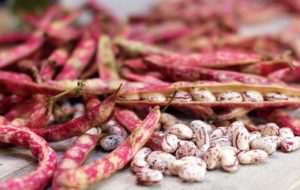
Infusion of crushed pods - 4 tbsp. l. - pour 3 tbsp.boiling water and simmer in a water bath for up to 15 minutes, insist 45 minutes, filter through several layers of gauze and take 1 glass before each meal.
The benefits of the sugar-reducing effect can be enhanced by adding blueberry leaves to the pods of red beans: such an infusion is taken in a third of a glass in 5 doses with meals.
With diseases of the gastrointestinal tract
To avoid harm, use red beans from the gastrointestinal tract with caution. Boiled beans in soups and salads, as well as a specially prepared broth, have a beneficial effect. It is prepared in a standard way: beans, 1 tbsp. l., boiled in 1 tbsp. water over low heat for 30 minutes, and the liquid is drained and cooled. Take 2 tablespoons after each meal.
With urolithiasis
Stones and sand from the kidneys and gallbladder tends to remove a decoction prepared from 20 g of plant flowers, which are infused in a glass of boiling water for up to 10 minutes. Take 4 times a day for half a glass.
For quick wound healing
An antiseptic beneficial effect is provided by ground red beans. For convenience, water is added to such flour in a 1: 1 ratio. It will be useful to mix honey with such a cake. Apply periodically as a compress until the desired effect is obtained on areas of burns, purulent skin inflammations, eczema lesions: the agent will dry out inflammation and block the growth of microbes.
The use of red beans in cosmetology
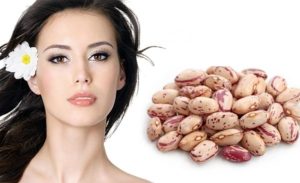
The benefits of the effect of red beans on the appearance are eloquent, since the regular use of boiled beans has a rejuvenating effect and removes age spots. The skin becomes matte, elastic, like after an expensive cosmetic procedure in a beauty salon.
The antibacterial beneficial properties of beans prevent skin rashes, acne, and acne from harm.
Unfortunately, red bean recipes are not as popular because of the stiffness of the bean and the length of time it takes to process. However, patience will be rewarded with interest: women with mature and dehydrated skin will appreciate the benefits of red bean puree: masks will bring a nourishing and lifting effect.
Reported Skin Benefits of Red Beans:
- food;
- toning;
- cleansing;
- smoothing wrinkles;
- whitening pigmentation.
For a standard mask, puree is used as a base with the addition of honey, olive oil, sea buckthorn juice.
Red Bean Purifying Mask
1 tablespoon of beans is ground in a coffee grinder and combined with clay (kaolin). The prepared mixture is applied to cleansed skin for 3-4 minutes, then washed off. For a beneficial effect, it will be enough to carry out the procedure once a week.
Red bean anti-wrinkle mask
Lemon juice and olive oil are added to well-cooked beans and interrupted with a blender until puree. Apply along massage lines, except for the area around the eyes. With regular use, the beneficial properties of the mask will be manifested in wrinkle smoothing and lifting effect.
Bean flour is also used in quick hair masks with the addition of milk, natural yogurt or sour cream (for oily hair). Such express masks are applied to the hair roots, left for 5 minutes, then washed off with water.
Red beans in cooking
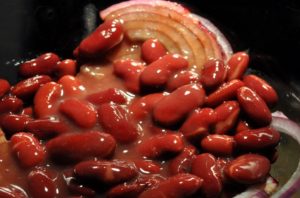
The use of red beans in cooking is so diverse that it is worthy of a separate cookbook publication. Healthy first courses, side dishes, salads are prepared with this bright bean plant. The vegetable is also used as a filling in pies, rolls, etc.
As a separate dish in Latin American countries, the vegetable is prized in a spicy version: chili is prepared from minced meat with tomatoes and peppers; stew, lobio from red meat, seasoned with tomato sauce, curry, herbs and nuts; make burrito, thick cholent soup.
In Ukraine, red beans are used as an ingredient in borscht and beetroot salads. In Jordan, they make yeast dough with boiled beans, which are usually served with garlic yogurt.
How to cook red beans properly
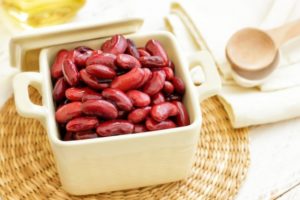
Given the ambiguous effects of red beans on the gastrointestinal tract, in order to avoid the harm of flatulence, it will be useful to master the correct processing technique for the product.
The most common way to cook red legumes is by soaking.
Soaking types:
- Slow - in cold water, at night or for 8 hours. To prevent fermentation, change the water 2 times or put in a cold place. The beneficial effect is manifested in the saturation of the product with water, due to which the beans are evenly boiled and freed from harmful substances.
Attention! Before cooking, be sure to change the water: it is impossible to boil the beans in the liquid that remained after soaking because of the harm of food poisoning!
- Hot - red beans are boiled for 2 minutes, removed from heat and kept under the lid for up to 3 hours (some are left up to 8 hours).
The benefits of the process of soaking red beans is also manifested in the neutralization of indigestible carbohydrates and phytohemagglutin with water, the toxic properties of which are harmful to poisoning the body.
The soaked red beans are boiled over low heat in clean water for up to 2 hours.
How to cook red beans in a slow cooker:
What is red beans combined with
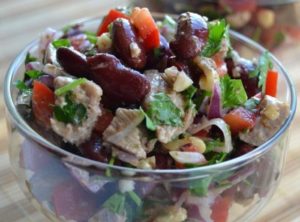
Red beans go well with a variety of vegetables and herbs, among them the most popular are tomatoes, onions, cilantro. As a side dish, it is in perfect harmony with meat and fish. The most popular dish of this product, lobio, is supplemented with walnuts, hops-suneli, garlic and tkemali sauce.
Large red beans in chili are combined with meat, peppers and curry.
And the small red adzuki beans (which have the highest amount of antioxidants) are good for salad with apple, green celery, walnuts and mayonnaise.
Harm of red beans and contraindications
It is difficult to talk about red beans, which provide such a wide range of benefits for the human body, as a product that can be harmful. The only serious hazard mentioned above comes from unsoaked or uncooked beans without cooking.
The relative harm of the product can be attributed to the metabolic problem, which, in addition to soaking, can also be neutralized by adding spices and fresh dill to the dish.
Selecting and storing red beans

When buying dried beans in a package, it is necessary to check the integrity of the package and the shelf life of the product.
When choosing a product by weight, you need to check for damage on the beans themselves - it can be cracks on the surface of the shells or traces of insects.
When choosing canned beans, along with information on the shelf life, you should check the composition of the product: it should not contain salt and food additives of chemical origin.
Dried beans are stored for up to 1 year in special, usually glass, hermetically sealed containers - in dark, cool and dry spaces, for example, closets.
Cooked beans can be refrigerated in a sealed container for up to 3 days.
Conclusion
The benefits and harms of red beans have been well studied in nutrition. Despite the specific rules for the preparation of beans, they have a powerful therapeutic effect in a number of diseases, therefore, they are indicated both in a complex of therapy and as a daily healthy diet, taking into account contraindications to use.

